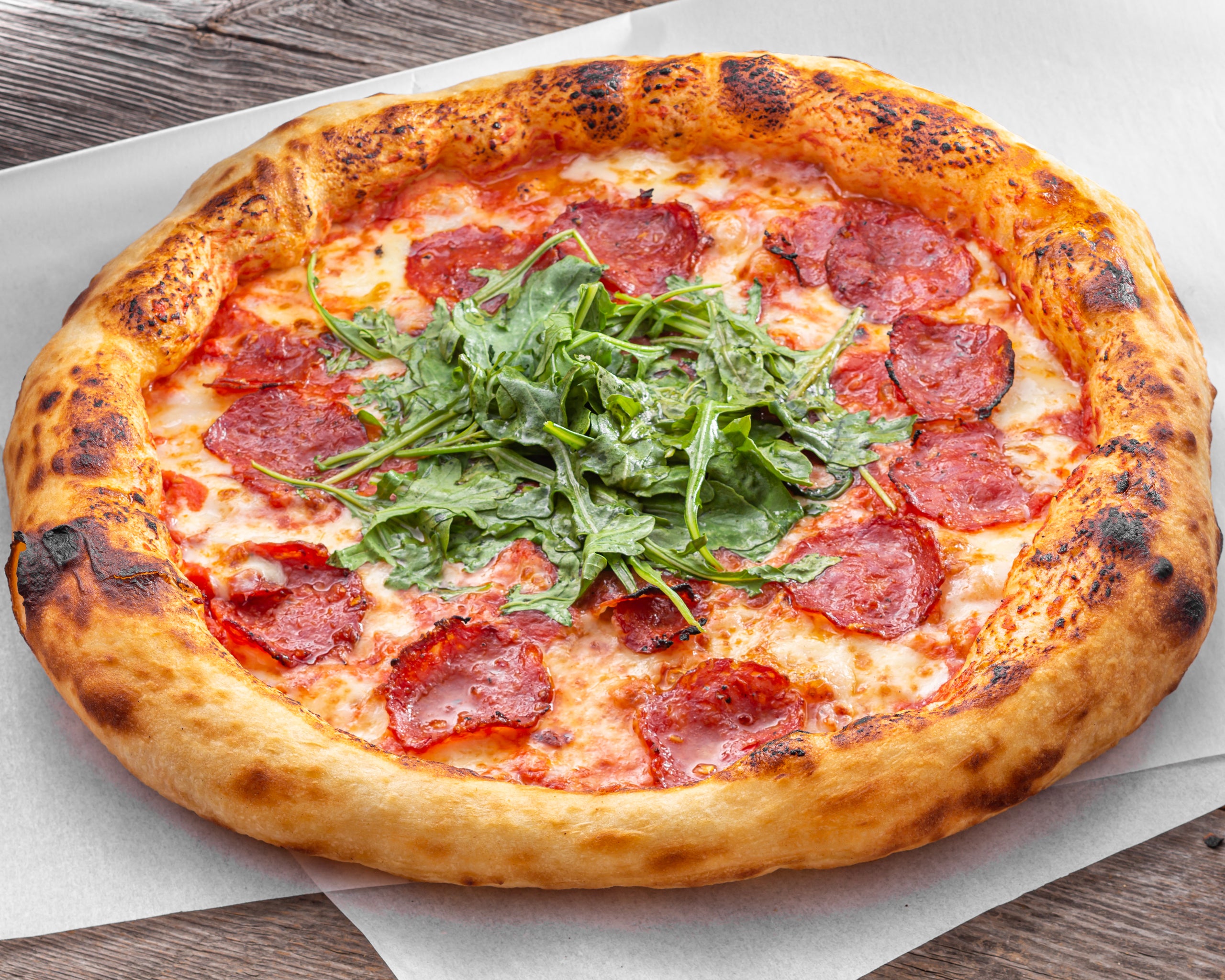The Ultimate Guide to Calabrese Pizza: A Slice of Southern Italy

Introduction
Calabrese pizza is a delightful and spicy variation of traditional Italian pizza that originates from the Calabria region in Southern Italy. Known for its bold flavors, this pizza stands out with its unique toppings, including spicy ‘nduja sausage, olives, and peppers. Calabrese pizza has earned its place in the hearts of pizza lovers worldwide due to its distinct taste and cultural significance.
While pizza is enjoyed all over Italy, the Calabrese style has a special place in the culinary landscape of the country. The combination of simple yet flavorful ingredients creates a pizza that is both hearty and satisfying. The key to its deliciousness lies in the use of fresh, regional ingredients that provide a perfect balance of heat and savory flavors. In this guide, we’ll explore everything you need to know about Calabrese pizza, from its origins and ingredients to how it’s made and how to enjoy it at its best.
What is Calabrese Pizza?
Calabrese pizza, or Pizza Calabrese, is a variation of traditional Italian pizza that hails from the Calabria region in the southernmost part of Italy. Known for its bold, spicy flavors, this pizza is a perfect representation of Calabria’s rich culinary traditions. What makes Calabrese pizza distinct is its use of locally sourced, flavorful ingredients such as ‘nduja sausage, a spicy spreadable pork sausage, and chili peppers, which are grown abundantly in the region. The heat from these ingredients is balanced by the freshness of the pizza’s other toppings and the rich, tangy tomato sauce.
In addition to its fiery flavor, Calabrese pizza often features a crispy, thin crust that is slightly charred on the edges, providing a perfect contrast to the softness of the toppings. Unlike the more universally known Neapolitan pizza, Calabrese pizza is less about simplicity and more about bold flavors that reflect the fiery spirit of the region. While Calabrese pizza is a beloved regional dish in Italy, its unique combination of ingredients and spices has made it popular in many other countries, including the United States, where it is often found in Italian restaurants and pizzerias.
Traditional Ingredients of Calabrese Pizza

The heart and soul of any Calabrese pizza lie in its ingredients. The base of this pizza consists of a simple, yet perfectly crafted dough that is thin and crisp, but still soft enough to hold all the toppings. The dough is made from high-quality flour, water, yeast, salt, and olive oil. This simple recipe is the foundation for a pizza that is rich in flavor, yet not overwhelming.
One of the key ingredients that set Calabrese pizza apart is the tomato sauce. Unlike some pizza varieties that use a rich, cooked tomato sauce, Calabrese pizza typically uses a fresh tomato sauce, often seasoned with garlic, olive oil, and a touch of chili flakes. This sauce is spread thinly over the dough to avoid overpowering the other flavors.
The cheese on a Calabrese pizza is traditionally mozzarella, which adds a creamy, milky flavor that complements the spicy toppings. In some variations, you might also find provolone or ricotta, which bring an additional depth of flavor to the pizza. However, it’s the toppings that really define this pizza. The most notable topping is ’nduja, a spicy, spreadable sausage made from pork, chili peppers, and various seasonings. This ingredient provides a bold, spicy kick that is characteristic of the Calabrese region. Alongside ‘nduja, you’ll often find black olives, roasted peppers, and onions, which help to balance the heat and add a savory, slightly sweet contrast to the pizza’s flavor profile.
How Calabrese Pizza is Made
Making Calabrese pizza at home can be an enjoyable and rewarding experience. The process begins with preparing the dough, which should be left to rise for at least a couple of hours to achieve the perfect texture. The dough is rolled out thin, ensuring it will bake into a crisp, crunchy base. Once the dough is ready, it’s time to spread the sauce.
The sauce for Calabrese pizza is typically made from ripe tomatoes, which are crushed and mixed with olive oil, garlic, and a pinch of chili flakes. The sauce should be light and fresh, allowing the toppings to shine. After spreading the sauce evenly over the dough, it’s time to add the cheese. Fresh mozzarella is the go-to cheese for this pizza, but you can also experiment with other cheeses like provolone for a slightly sharper taste.
The next step is to add the signature toppings. A generous amount of ‘nduja sausage is spread across the pizza, allowing the spicy, smoky flavors to infuse the dish. Roasted peppers, black olives, and onions are then scattered over the pizza, creating a colorful and flavorful topping. Once all the ingredients are in place, the pizza is baked in a very hot oven, ideally at around 475°F (245°C), for about 10-15 minutes, or until the crust is golden brown and crispy.
One of the most important aspects of making Calabrese pizza is ensuring that the crust is perfectly crisp while the toppings remain fresh and flavorful. A wood-fired oven is ideal for achieving this balance, as the high heat creates a crispy exterior while keeping the toppings tender and full of flavor. For those making it at home, a pizza stone or baking steel can be used to replicate the effects of a wood-fired oven.
Regional Variations and Modern Twists
While Calabrese pizza has its roots in the Calabria region, it has evolved over time, with different variations appearing in other parts of Italy and the world. In some areas of Calabria, for instance, the pizza might feature additional toppings such as anchovies or capers, which are also common in Southern Italian cuisine. The type of ‘nduja used can also vary, with some versions being spicier or milder depending on the region. Additionally, the use of different types of cheese, such as provolone or ricotta, can give the pizza a slightly different flavor profile.
Modern twists on the traditional Calabrese pizza often incorporate other regional Italian ingredients or even non-Italian influences. For example, some chefs might add a drizzle of honey to balance the spiciness of the ‘nduja or experiment with different crust types, such as gluten-free or whole wheat options. In more experimental kitchens, you might even find a fusion version of Calabrese pizza, where ingredients from other cultures, such as jalapeños or chorizo, are used to create a unique hybrid pizza that still retains the essential elements of the Calabrese style.
While these modern variations can be exciting, they often maintain the spirit of Calabrese pizza by keeping the bold, spicy flavors at the forefront. Whether you stick to the traditional recipe or explore new twists, the essence of Calabrese pizza remains the same: it’s a dish full of flavor, passion, and history.
Pairing Calabrese Pizza with Drinks
Calabrese pizza is a bold, spicy dish, so it pairs wonderfully with drinks that can either complement or contrast its heat. The most obvious choice for pairing is wine, particularly wines from the Calabria region. A rich, full-bodied red wine such as Cirò, which is made from the Gaglioppo grape, complements the spicy flavors of the ‘nduja and enhances the overall pizza experience. Other red wines, such as Sangiovese or Zinfandel, also work well, as they have enough acidity and fruitiness to balance the heat.
For beer lovers, a crisp, refreshing craft beer can provide a great contrast to the richness of the pizza. A pale ale or IPA with a bit of bitterness can cut through the spiciness, while a wheat beer or pilsner offers a lighter, more refreshing option. Non-alcoholic drinks like sparkling water or an iced tea with lemon can also work well, offering a refreshing break from the heat without overpowering the flavors of the pizza.
Conclusion
Calabrese pizza is a bold and flavorful dish that represents the rich culinary traditions of Southern Italy. With its spicy ‘nduja sausage, fresh tomato sauce, and simple yet satisfying ingredients, it’s no wonder that Calabrese pizza has become a favorite for pizza lovers around the world. Whether you enjoy it in its traditional form or try out some modern variations, this pizza is sure to leave a lasting impression on your taste buds. So, the next time you’re in the mood for something a little different, give Calabrese pizza a try—you won’t regret it!
You May Also Read:https://topusanetwork.com/marry-me-chicken-pasta/




